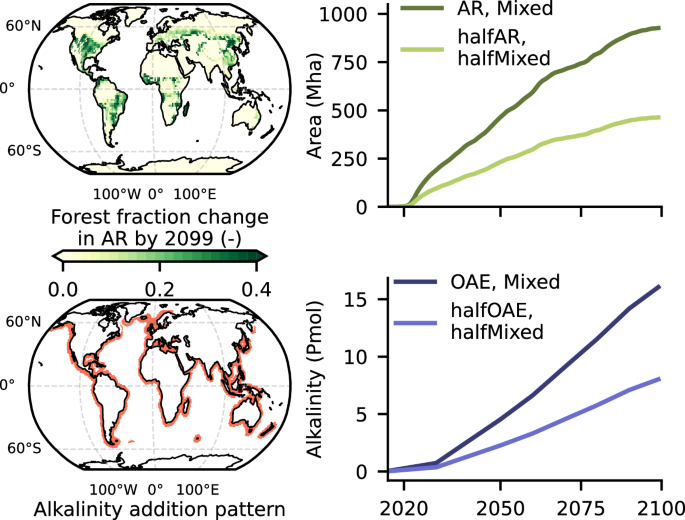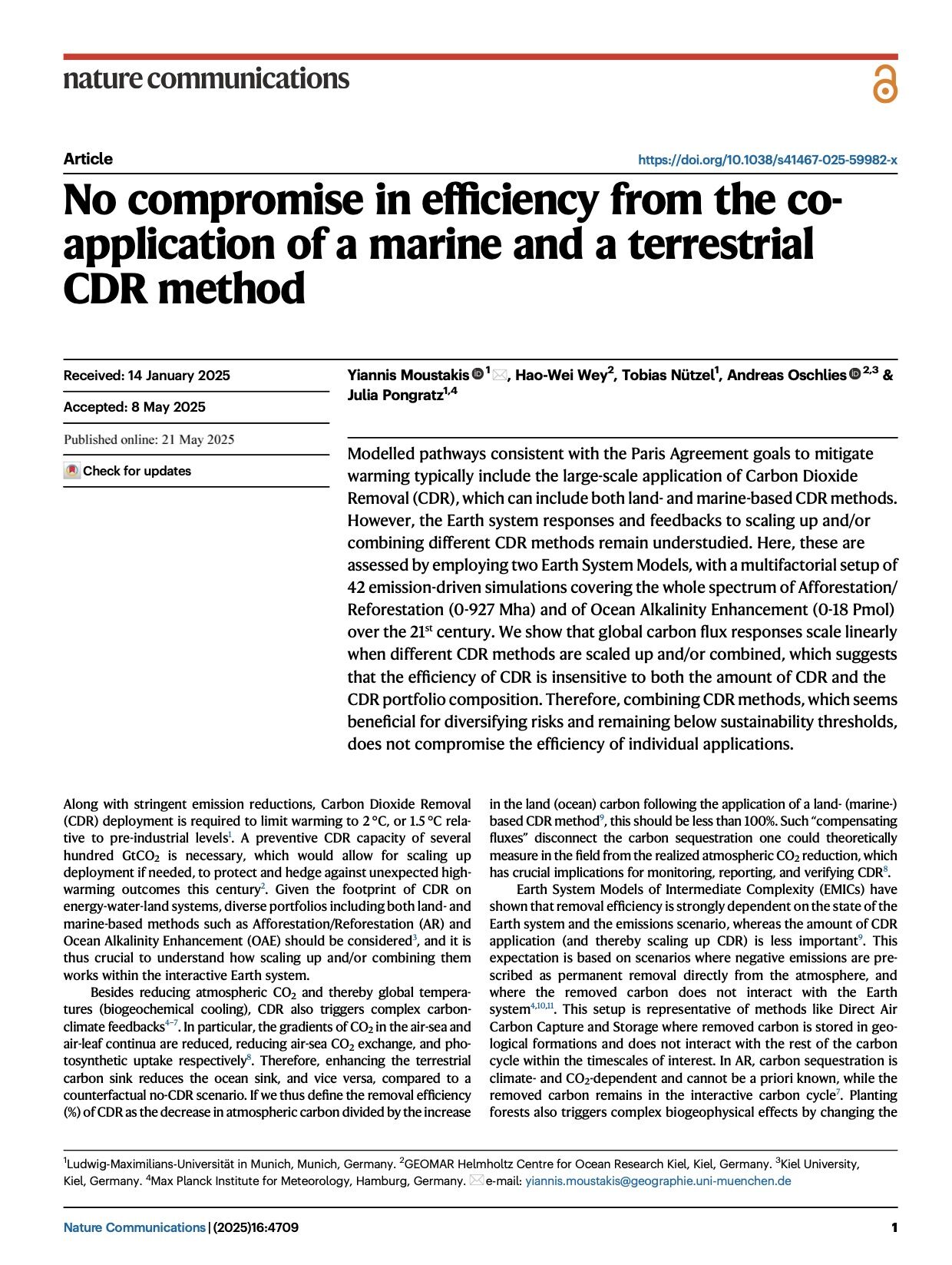Modelled pathways aligned with the goals of the Paris Agreement to mitigate global warming generally include large-scale application of carbon dioxide removal (CDR), encompassing both terrestrial and marine methods. However, the Earth system’s responses and feedbacks to scaling up and/or combining different CDR methods remain underexplored. Here, we assess these dynamics using two Earth system models in a multifactorial setup of 42 emission-driven simulations. These simulations span the full spectrum of afforestation/reforestation (AR) (0–927 Mha) and ocean alkalinity enhancement (OAE) (0–18 Pmol) deployments throughout the 21st century.
We show that global carbon flux responses scale linearly when various CDR methods are scaled and/or combined. This suggests that CDR efficiency is insensitive to both the amount of CDR deployed and the composition of the CDR portfolio. Therefore, combining methods, which appears beneficial for risk diversification and maintaining sustainability thresholds, does not compromise the individual efficiency of each CDR application.
Introduction
Alongside aggressive emission reductions, carbon dioxide removal (CDR) is necessary to limit warming to 2 °C—or preferably 1.5 °C—above pre-industrial levels. Several hundred GtCO₂ of preventive CDR capacity is required to enable rapid scaling if necessary, offering protection against unexpected outcomes from high-end warming. Given CDR’s footprint on energy-water-land systems, diverse portfolios involving terrestrial and marine methods such as afforestation/reforestation (AR) and ocean alkalinity enhancement (OAE) must be considered. Understanding how these approaches scale and interact within the complex Earth system is therefore crucial.
In addition to directly lowering atmospheric CO₂ and global temperatures (biogeochemical cooling), CDR also induces complex carbon–climate feedbacks. For example, the air-sea and air-leaf CO₂ gradients are reduced, decreasing air-sea CO₂ exchange and photosynthetic uptake, respectively. As a result, enhancing one carbon sink (e.g., terrestrial) reduces the effectiveness of the other (e.g., oceanic), relative to a no-CDR scenario.
If CDR efficiency is defined as the reduction in atmospheric carbon divided by the increase in terrestrial (or oceanic) carbon from a CDR method, the efficiency must be below 100%. Such “compensating fluxes” decouple measurable carbon sequestration from actual atmospheric CO₂ reduction, posing challenges for monitoring, reporting, and verification.
Intermediate complexity Earth system models (EMICs) have shown that removal efficiency depends heavily on the state of the Earth system and emissions scenarios, while the quantity of CDR applied is less critical. This is based on scenarios where CO₂ is removed permanently from the atmosphere, with no further interaction with the carbon cycle—as is the case with direct air capture and geological storage. In contrast, AR and OAE interact with the active carbon cycle and their effectiveness depends on biogeophysical and biogeochemical factors, which cannot be precisely predicted in advance.
Thus, high-complexity Earth System Models (ESMs), which capture such feedbacks, are necessary to determine whether removal efficiency remains stable across different CDR scales and portfolios. Even if true, combined CDR effects may not equal the sum of individual effects due to nonlinear interactions. For instance, Keller et al. (using an EMIC) suggested that combining AR, OAE, and ocean iron fertilization produces a saturating response, but this hasn’t been tested with an ESM.
Similarly, doubling the CDR deployment doesn’t necessarily double the CO₂ removal. Such linearity would require that the carbon uptake per unit of CDR remains unaffected by deployment scale. While Schwinger et al. recently confirmed this for OAE, it remains untested for AR or combined deployments.
To improve confidence in our findings, we examine the scaling and interaction of AR and OAE using two ESMs—Max Planck Institute Earth System Model (MPI-ESM) and Flexible Ocean and Climate Infrastructure (FOCI)—under an emission-driven setup where atmospheric CO₂ is dynamically calculated. We apply up to 927 Mha of AR and up to 18 Pmol of OAE globally by 2099, both individually and combined, following fossil emissions from the SSP3-7.0 scenario. This yields a multifactorial matrix of 7 scenarios and 42 simulations.
We find that global carbon fluxes scale linearly across this full spectrum of AR and OAE, supporting the conclusion that removal efficiency is insensitive to both the scale and composition of CDR deployment.

(Top) Map shows the afforestation/reforestation (AR) pattern as a change in forest cover fraction by 2099 in AR/mixed scenarios. For halfAR/halfMixed, the spatial pattern is the same but scaled down by half. The line graph shows global forest area increase over time (in Mha), as detailed in Moustakis et al.
(Bottom) Map indicates coastal grid cells where alkalinity is added. Line graphs show cumulative added alkalinity (in Pmol) over time.
Results and Discussion
Scaling Up CDR Produces Linear Carbon Flux Responses
In the halfAR scenario, terrestrial carbon (C_terrestrial) increases by 258 GtCO₂, with uptake reaching 56 GtCO₂ per 100 Mha by 2099. This value reflects the cumulative carbon sequestration by planted forests from the beginning of the deployment, depending on land characteristics. The model prioritizes reforestation over afforestation, converting higher potential lands first. However, this increase primarily reflects rising atmospheric CO₂ concentrations enhancing photosynthesis.
This CO₂ dependency becomes evident when compared with Moustakis et al., who used the same model configuration under lower SSP5-3.4os emissions, reporting a lower uptake of ~40 GtCO₂ per 100 Mha by 2100.




